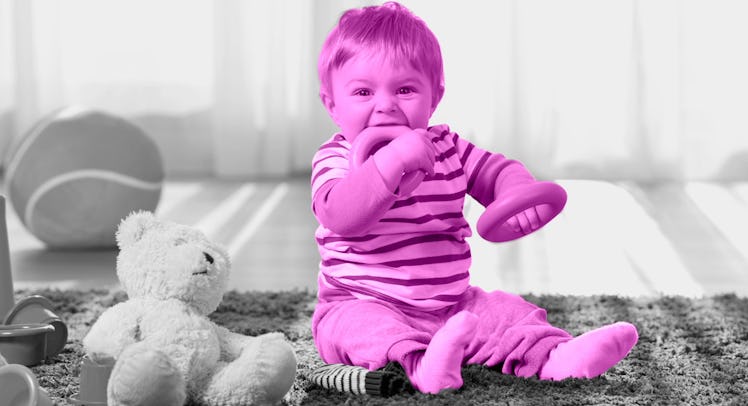How to Stop Toddler Biting
Toddlers are directed by habit and nature to chomp away. Parents can help make sure they chomp appropriately.

Toddler biting is linked to comfort and calm. But that doesn’t make it any less hard for parents to deal with. But, knowing how to stop a toddler from biting begins with knowing they really aren’t aggressive. Toddlers that bite are simply continuing habits learned a few months earlier when they were babies, and for the same reasons, not related to anger or frustration, but mouth discomfort. Luckily parents can help toddlers manage the biting habit and keep new teeth out of siblings and furniture.
“From the ages of 12 to 18 months, toddlers are cutting some serious teeth,” says Melanie Potock, a pediatric speech pathologist, feeding specialist and author of Adventures in Veggieland. While not every myth about teething is true, the whole ‘gotta bite’ feeling probably is. Biting isn’t necessary for teeth to erupt, but it can relieve their discomfort, and it’s also a primary way kid’s self-soothe.
“They are seeking input to help them calm,” explains Potock. “That’s why babies suck for comfort.” This kind of self-soothing is a manifestation of the rooting reflex, and also the idea behind the pacifier. When a toddler is frustrated or overstimulated, they can seek out sensory input to help them focus or distract them from discomfort. And the mouth is still a premier sensory structure, even for a toddler. In fact, with their improved mobility, toddlers can seek out new and interesting things to bite.
How to Stop a Toddler from Biting
- Toddlers have a ton of reasons to bite: they’re teething; it helps them feel better; they can reach more things to bite; and it solves problems for them.
- Biting won’t go away at this age, but it can be redirected: teething necklaces can provide sensory input, while cold washcloths and chilled teethers can help soothe sore gums. Whistles, bubbles and toy harmonicas can also substitute for many biting behaviors.
- Set them up for success; if they simply don’t get along with a classmate or playmate, don’t force them into an agitating situation.
- Reward good behavior: when a toddler plays well, without resorting to the teeth to solve problems, parents need to praise that kind of decision-making.
Toddlers may also use biting as a form of problem-solving. “Kids this age do what works,” says Potock. “Want the toy that your playmate has in his little fist? It only takes a few exploratory chomps on another child’s arm to discover that he’ll scream and drop the toy, and now it’s yours!” Toddlers have limited tools at their disposal, so when they find one that works, they use it. They are also more likely to learn from biting specifically if the subject doesn’t like it.
“Kids have good memories for cause and effect by age one. It’s not just that they understand cause and effect; they remember that ‘if this happens, then that happens,’” explains Potock. “Emotional behavior, like biting and getting someone to scream is more likely to be remembered, too.”
So kids have lots of reasons to keep biting, and they probably will for at least a few months (or a few more years.) Instead of trying to get toddlers to stop biting, managing this behavior should focus on directing those bites in an appropriate way, at least from ages 12 to 18 months.
“Remember that most biting behavior on sleeves, toys and cribs is purposeful, helping kids organize their sensory system and giving the input they need to calm and focus on good behavior,” advises Potock. “So give kids lots of opportunities to bite in a socially acceptable way.”
Toddler chew toys are good examples. They can hang from pacifier clips, be worn as break-away safety necklaces, or carried in hand like a pint-sized stevedore. Kids are less likely to settle for a moving target like a sibling when they have teethers on hand. Blowing activities can substitute stimulation in place of biting. Large train whistles, bubbles and toy harmonicas help kids calm down and react less impulsively.
When kids bite out of frustration, it takes a little more work. “Pay attention to where and when the biting behavior occurs,” suggests Potock. “Is it always with a specific playmate? Is it always during circle time at daycare? Is it when your toddler is climbing and just wants another kid to get out of the way?”
Providing another outlet for the rooting reflex before play can help reduce stress. If the same playmate keeps getting the fangs, it’s worth making sure both kids have plenty of space when they play; there’s no sense in inviting trouble by sitting them next to each other or forcing them together. This may seem a bit like helicopter parenting, but these are toddlers, after all; parents need to create spaces for them to learn the right behaviors, and make sure those behaviors are rewarded.
“When your toddler doesn’t bite in that situation, praise him for being gentle and kind to his friend,” says Potock. “You are creating a new memory, filled with positive emotions. Over time, that behavior will become more prominent and the biting behavior will go away.“
This article was originally published on